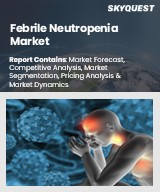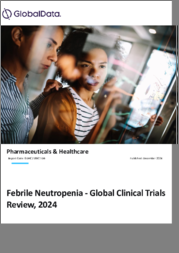
|
시장보고서
상품코드
1518526
화학요법 유발성 호중구 감소증 치료 시장 : 치료 유형, 약제 유형, 투여 경로, 유통 채널별, 예측(2024-2032년)Chemotherapy-Induced Neutropenia Treatment Market - By Treatment Type (G-CSF, Antibiotics, Granulocyte Transfusion, Antifungals), Drug Type (Branded, Biosimilars), Route of administration (Parenteral, Oral), Distribution Channel & Forecast, 2024 - 2032 |
||||||
세계의 화학요법 유발성 호중구 감소증 치료 시장 규모는 바이오시밀러 승인을 향한 유리한 규제 경로와 처방자 및 환자 사이에서의 수용 확대에 의해 2024-2032년에 CAGR 3.7%를 기록합니다.
암을 포함한 만성질환의 확산은 시장의 주요 성장 요인으로, CDC 보고서에 따르면 미국에서는 매년 170만 명이 암 진단을 받고 60만 명 이상이 사망하여 사망 원인 중 2위를 차지하고 있습니다. 암 치료 비용은 지속적으로 증가하고 있으며, 2030년에는 2,400억 달러 이상에 달할 것으로 예상되고 있습니다. 전 세계에서 암 환자가 급증함에 따라 화학요법이 치료제로 사용되면서 화학요법 유발성 호중구감소증(CIN)의 가능성이 높아지고 있으며, CIN의 합리적 관리에 대한 수요가 증가함에 따라 바이오시밀러와 같은 혁신적인 치료 옵션의 잠재력이 부각되고 있습니다. 바이오시밀러 의약품은 기존 치료제에 대한 비용 효율적인 대안을 제공함으로써 접근성이 높고 비용 효율적인 호중구감소증 치료에 대한 수요 증가에 부응하고 시장 성장을 가속하고 있습니다.
화학요법 유발성 호중구감소증 치료 산업은 치료 유형, 약물 유형, 투여 경로, 유통 채널 및 지역에 따라 분류됩니다.
바이오시밀러 분야는 기존 치료법에 대한 비용 효율적인 대체 요법을 제공함에 따라 2032년까지 빠르게 성장할 것으로 예상됩니다. 호중구감소증 치료에 바이오시밀러를 사용할 수 있게 됨에 따라 의료 서비스 프로바이더는 의료 비용을 줄이면서 치료 요법을 최적화할 수 있게 되었습니다. 또한 전 세계에서 의료 인프라는 환자 치료의 질을 떨어뜨리지 않으면서도 비용을 절감할 필요가 있으며, 바이오시밀러의 도입은 안전 기준을 유지하면서 경제적 부담을 줄일 수 있는 매력적인 솔루션으로 이 부문의 성장을 가속할 것으로 보입니다.
경구용 치료제 부문은 편의성과 유연성으로 인해 2024-2032년 동안 완만하게 성장할 것으로 예상됩니다. 호중구감소증 치료를 위한 경구용 솔루션의 개발로 환자 중심의 치료가 가능해져 외래 또는 집에서 편안하게 치료를 받을 수 있게 되었습니다. 또한 약물전달 기술의 혁신으로 경구용 제제의 생체 이용률과 약동학이 개선되어 그 사용이 더욱 증가하고 있습니다.
유럽의 화학요법 유발성 호중구 감소증 치료 시장 규모는 탄탄한 의료 인프라와 높은 암 발병률로 인해 2024-2032년 강력한 성장세를 보일 것으로 예상됩니다. 독일, 영국, 프랑스와 같은 국가들이 종양학에 대한 투자와 첨단 치료법 채택으로 산업 성장을 주도하고 있습니다. 또한 제약회사와 연구기관의 협력으로 호중구감소증에 대한 새로운 치료법을 개발하고 상용화할 수 있게 되었습니다. 이 지역의 암 치료에 대한 적극적인 접근 방식과 유리한 정책은 세계 시장에서 주목할 만한 위치에 기여하고 있습니다.
목차
제1장 조사 방법과 조사 범위
제2장 개요
제3장 업계 인사이트
- 에코시스템 분석
- 업계에 대한 영향요인
- 촉진요인
- 암의 유병률 증가
- 화학요법의 보급
- 치료 옵션의 기술적 진보
- 정부의 구상과 자금 제공의 증가
- 업계의 잠재적 리스크 & 과제
- 높은 치료비
- 치료에 의한 부작용
- 촉진요인
- 성장 가능성 분석
- 규제 상황
- 파이프라인 분석
- Porter의 산업 분석
- PESTEL 분석
- 향후 시장 동향
제4장 경쟁 구도
- 서론
- 기업 매트릭스 분석
- 주요 시장 기업의 경쟁 분석
- 경쟁 포지셔닝 매트릭스
- 전략 대시보드
제5장 시장 추산·예측 : 치료 유형별, 2021-2032년
- 주요 동향
- 과립구 집락자극인자 요법
- 항생제 요법
- 과립구 수혈
- 항진균제
- 기타 치료 유형
제6장 시장 추산·예측 : 약제 유형별, 2021-2032년
- 주요 동향
- 브랜드약
- 바이오시밀러
제7장 시장 추산·예측 : 투여 경로별, 2021-2032년
- 주요 동향
- 비경구
- 경구
제8장 시장 추산·예측 : 유통 채널별, 2021-2032년
- 주요 동향
- 병원 약국
- 소매 약국
- 온라인 약국
제9장 시장 추산·예측 : 지역별, 2021-2032년
- 주요 동향
- 북미
- 미국
- 캐나다
- 유럽
- 독일
- 영국
- 프랑스
- 스페인
- 이탈리아
- 네덜란드
- 기타 유럽
- 아시아태평양
- 중국
- 일본
- 인도
- 호주
- 한국
- 기타 아시아태평양
- 라틴아메리카
- 브라질
- 멕시코
- 아르헨티나
- 기타 라틴아메리카
- 중동 및 아프리카
- 남아프리카공화국
- 사우디아라비아
- 아랍에미리트
- 기타 중동 및 아프리카
제10장 기업 개요
- Amgen Inc.
- BeyondSpring Inc.
- Biocon Biologics Inc.
- Cellerant Therapeutics
- Coherus BioSciences, Inc.
- Evive Biotech
- Kyowa Kirin Co., Ltd.
- Novartis AG
- Pfizer Inc.
- Sanofi
- Spectrum Pharmaceuticals
- Teva Pharmaceutical Industries Ltd.
The global chemotherapy-induced neutropenia treatment market size will register 3.7% CAGR during 2024-2032, owing to favorable regulatory pathways for approval of biosimilars and growing acceptance among prescribers and patients.
Prevalence of chronic diseases including cancer is a major growth factor for the market. According to the CDC report, in the US, 1.7 million people are diagnosed with cancer annually, with over 600,000 fatalities, making it the second leading cause of death. The cost of cancer care is continually increasing and is projected to exceed $240 billion by 2030. As the cases of cancer surge worldwide, so does the use of chemotherapy as a treatment modality, increasing the likelihood of chemotherapy-induced neutropenia (CIN). This growing demand for rational management of CIN highlights the viability of innovative treatment options such as biosimilars. By providing cost-effective alternatives to conventional treatments, biosimilars address the growing need for accessible and cost-effective neutropenia treatments, which is driving market growth.
Chemotherapy-induced neutropenia treatment industry is classified based on treatment type, drug type, route of administration, distribution channel, and region.
The biosimilars segment will grow rapidly through 2032, as they offer cost-effective alternative to conventional therapies. The increasing availability of biosimilars for the treatment of neutropenia has given healthcare providers the opportunity to optimize treatment regimens while reducing healthcare costs. Additionally, as healthcare infrastructure worldwide is under increased pressure to contain costs without compromising patient care, the introduction of biosimilars is an attractive solution to lighten the financial burden while maintaining safety standards, which will drive growth in the segment.
The oral formulations segment will grow moderately during 2024-2032, due to the convenience and flexibility. The development of oral solutions to treat neutropenia enable patient-centered treatments so that people can receive treatment on an outpatient basis or even in the comfort of their own home. In addition, innovations in drug delivery techniques have increased the bioavailability and pharmacokinetics of oral formulations, further increasing their use.
Europe chemotherapy-induced neutropenia treatment industry size will grow strongly between 2024 and 2032, due to robust healthcare infrastructure and high incidence of cancer. Countries such as Germany, the United Kingdom and France are leading industry growth, fueled by investments in oncology and the adoption of advanced treatments. In addition, collaboration between pharmaceutical companies and research institutes enables the development & commercialization of new treatments for neutropenia. The region's proactive approach to cancer treatment and favorable policies contribute to its notable position in the global market.
Table of Contents
Chapter 1 Methodology & Scope
- 1.1 Market scope & definitions
- 1.2 Research design
- 1.2.1 Research approach
- 1.2.2 Data collection methods
- 1.3 Base estimates & calculations
- 1.3.1 Base year calculation
- 1.3.2 Key trends for market estimation
- 1.4 Forecast model
- 1.5 Primary research and validation
- 1.5.1 Primary sources
- 1.5.2 Data mining sources
Chapter 2 Executive Summary
- 2.1 Industry 360 degree synopsis
Chapter 3 Industry Insights
- 3.1 Industry ecosystem analysis
- 3.2 Industry impact forces
- 3.2.1 Growth drivers
- 3.2.1.1 Increasing prevalence of cancer
- 3.2.1.2 Growing adoption of chemotherapy
- 3.2.1.3 Technological advancements in treatment options
- 3.2.1.4 Rising government initiatives and funding
- 3.2.2 Industry pitfalls & challenges
- 3.2.2.1 High cost of treatment
- 3.2.2.2 Adverse effects of treatment
- 3.2.1 Growth drivers
- 3.3 Growth potential analysis
- 3.4 Regulatory landscape
- 3.5 Pipeline analysis
- 3.6 Porter's analysis
- 3.7 PESTEL analysis
- 3.8 Future market trends
Chapter 4 Competitive Landscape, 2023
- 4.1 Introduction
- 4.2 Company matrix analysis
- 4.3 Competitive analysis of major market players
- 4.4 Competitive positioning matrix
- 4.5 Strategy dashboard
Chapter 5 Market Estimates and Forecast, By Treatment Type, 2021 - 2032 ($ Mn)
- 5.1 Key trends
- 5.2 Granulocyte colony-stimulating factor therapy
- 5.3 Antibiotics
- 5.4 Granulocyte transfusion
- 5.5 Antifungals
- 5.6 Other treatment types
Chapter 6 Market Estimates and Forecast, By Drug Type, 2021 - 2032 ($ Mn)
- 6.1 Key trends
- 6.2 Branded
- 6.3 Biosimilars
Chapter 7 Market Estimates and Forecast, By Route of Administration, 2021 - 2032 ($ Mn)
- 7.1 Key trends
- 7.2 Parenteral
- 7.3 Oral
Chapter 8 Market Estimates and Forecast, By Distribution Channel, 2021 - 2032 ($ Mn)
- 8.1 Key trends
- 8.2 Hospital pharmacies
- 8.3 Retail pharmacies
- 8.4 Online pharmacies
Chapter 9 Market Estimates and Forecast, By Region, 2021 - 2032 ($ Mn)
- 9.1 Key trends
- 9.2 North America
- 9.2.1 U.S.
- 9.2.2 Canada
- 9.3 Europe
- 9.3.1 Germany
- 9.3.2 UK
- 9.3.3 France
- 9.3.4 Spain
- 9.3.5 Italy
- 9.3.6 Netherlands
- 9.3.7 Rest of Europe
- 9.4 Asia Pacific
- 9.4.1 China
- 9.4.2 Japan
- 9.4.3 India
- 9.4.4 Australia
- 9.4.5 South Korea
- 9.4.6 Rest of Asia Pacific
- 9.5 Latin America
- 9.5.1 Brazil
- 9.5.2 Mexico
- 9.5.3 Argentina
- 9.5.4 Rest of Latin America
- 9.6 Middle East and Africa
- 9.6.1 South Africa
- 9.6.2 Saudi Arabia
- 9.6.3 UAE
- 9.6.4 Rest of Middle East and Africa
Chapter 10 Company Profiles
- 10.1 Amgen Inc.
- 10.2 BeyondSpring Inc.
- 10.3 Biocon Biologics Inc.
- 10.4 Cellerant Therapeutics
- 10.5 Coherus BioSciences, Inc.
- 10.6 Evive Biotech
- 10.7 Kyowa Kirin Co., Ltd.
- 10.8 Novartis AG
- 10.9 Pfizer Inc.
- 10.10 Sanofi
- 10.11 Spectrum Pharmaceuticals
- 10.12 Teva Pharmaceutical Industries Ltd.



















